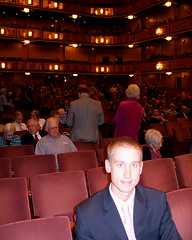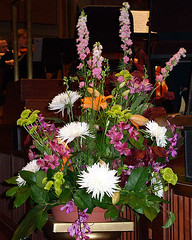We got there a bit early, since the Metro's been a bit undependable of late, so we wandered around the Kennedy Center and went out on the terrace to watch all the crews rowing up and down the river.


Some Swedish boys' school choir was singing in the far end of the Grand Foyer for the Millennium Stage. We listened about two minutes, then quickly moved on. Sometimes I have to be in the right mood to get engaged with choral performances.
Finally about a quarter to the hour, we wandered into the concert hall to find our seats. We were down on the right, first row, by the second violins and the percussionists. It's an okay place to sit, mostly because I like having all the extra leg room! We're also in the position to be able to watch the conductor work from the side, which I always find fascinating.


The concertmistress came out wearing black hostess pajama bottoms (why would she wear pants when all the men are in white tie and tails?) with a black sequined belt worn low on the hips gypsy style. Not one of her better outfits. Maestro Fischer came out in white tie. He's always fun to watch—and hear—since he's a very animated conductor with audible heavy breathes and vocalizations.
The Mahler Third is rather an unusual work, thought to have been inspired, in part, at least, by Friedrich Nietzsche's Also sprach Zarathustra (Thus spake Zoroaster). It's about a 90 minute piece, and half of it is devoted to the first of six movements. As I find typical of Mahler symphonies, I think the first and last movements are great, and the internal movements are okay, but they get rather sleepy. And, Mahler is one of those composers who can't quite put down the pen—you think the movement is over, but it goes on and on and five minutes later, he's still ending.
There's something about Mahler finales, though, that I love, especially the Second ("Resurrection"), but also in this work, that makes me feel the yearnings inside me being pulled and stretched by the music. It can be very emotional, and the NSO did a good job with the intensity and the feeling here in the Finale of the Third.
The beginning was impressive, too. Early in the opening phrases, we felt the distinct physical rumble of the low brass and then low woodwinds. In the middle, the trombone section provided terrifying music of the heavens, and ensemble member Craig Mulcahy did the solo work. The movement ended with the conductor punching the air like a boxer.
They took a short break after the first movement to get the choirs into the performance space. The university women were all attired in long black dresses. The children's choir wore wine colored sweater vests and white shirts, the boys in olive khaki trousers and the girls in olive-toned tartan plaid skirts. As the maestro reentered, we also saw for the first time the contralto soloist. Miss Remmert is an attractive young lady. She wore a simple long black dress held up by a wide strap over one shoulder. A sheer black thigh-length overlay with black sequined edges and clasped on the opposite shoulder from the dress strap finished the ensemble.
The second and third movements were pretty and pastoral, and the orchestra played well for Fischer. Movement four introduced Miss Remmert's voice to sing "Zarathustra's Midnight Song." The song, though, was short and did not afford Remmert much opportunity to show off her voice. Movement five used the two choirs, the children singing as bells and the women providing textual support. I had the impression that this movement didn't really belong in the symphony, as it had a light bounce to it that was out of context with the mood of the preceding and following movements.
Finally we got to the sixth and final movement, Adagio, beginning with a long exposition of the string section with such tight playing by the ensemble I was able to float on the music. The music was neither fast nor slow, it simply proceeded towards its goal. Fischer kept the energy and tension there to get that Mahlerian "pull," milking out every last emotion from the players and the audience. I do believe that Mahler's finale is so good that were I only to hear the one movement instead of the entire symphony, I would feel rewarded.

No comments:
Post a Comment